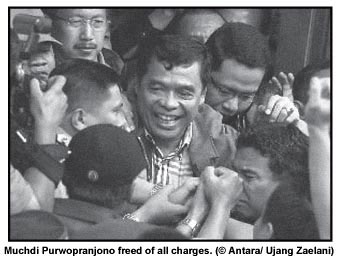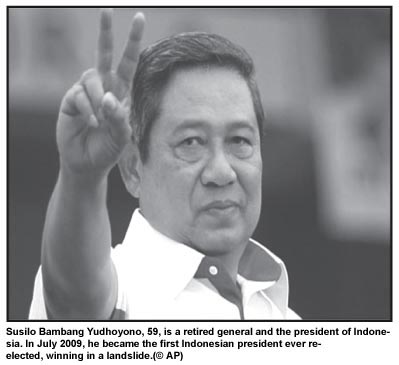by Atty. Sri Suparyarti
The five-year efforts to resolve the case of Munir
only show the lack of commitment on the part of the government to find
out the mastermind. Now, after the acquittal of the last defendant,
Muchdi Purwopranjono, he was released from prison through a court order
on 31 December 2008. This problematic situation is also supported by the
Attorney General who has not yet followed up the appeal for a case
review.
After his release, Muchdi Purwopranjono filed a
charge of defamation against KontraS Director, Usman Hamid. This
charge was issued by the Indonesian Police Department. The charge letter
mentioned that Mr. Hamid committed an act of defamation against Muchdi
Purwopranjono for accusing the latter as the killer of Munir. Allegedly,
Mr. Hamid has no right to tell the public who he believes as Munir’s
murderer, otherwise, he violates the Article 310 of the Criminal Code on
Defamation.
Both issues are the new progress in the process of
revealing the case of Munir in order to bring justice to the victim and
his family and to the Indonesian society. The case of Munir is a test of
our history, a test of other human rights violations which occurred in
Indonesia in the past. The case of Munir has a strong relation with past
abuses such as the 1997/1998 disappearance of activists and the massacre
of Talangsari, Lampung in 1984. With the renewed mandate of the
Indonesian president, will the Indonesian government pass this test?
This brief article attempts to look into the
developments of Munir’s murder and how far the government has
concretized its avowed commitment to uncover the mastermind. Is the
government serious in revealing the truth about the murder of
Indonesia’s strongest human rights defender? Is it really bent on
resolving, once and for all, this internationally-condemned murder?
The Release of the Key Planner
After the punishment of the Garuda crew, Pollycarpus,
the pilot who was accused of administering the poison and later
acquitted, was subjected to a case review by the Supreme Court. He was
sentenced to twenty years of imprisonment. While this conviction is a
victory in the search for justice, it is not enough element to fully
resolve the case, since the key planner still has to be punished. The
other defendant was General Muchdi Purwopranjono, who, because of an
alleged personal motive against the victim, was charged of killing Munir
under the Article 55 point (1) 2 KUHP (Indonesian Criminal Code);
of Article 340 KUHP or under Article 55 ayat (1) 1 KUHP
of Article 340 KUHP.1
To reiterate, the Attorney General hinted a personal motive
of the killing due to an alleged personal revenge of Muchdi against
Munir.2 Then, in the
explanation of this personal revenge, it was said that the murder was
related to the activity of Munir when he was advocating the resolution
of the enforced disappearance of activists in 1997 and 1998 where, at
that time, Muchdi was one of the members of Kopassus (Komando
Pasukan Khusus or Special Force Command) under the Rose team. Muchdi
was known to be responsible for the action.3
Accordingly, when Muchdi was the Deputy V of BIN (Badan
Intelijen Negara or State Intelligence Body), he was free to take
revenge against Munir.4
 The
next role of Muchdi was to kill Munir. Pollycarpus, a Garuda pilot, said
to be a person known to Munir, was allegedly in the position to kill
him. The relationship between Muchi and Pollycarpus was identified from
the position of Pollycarpus as an organic agent who conducted intensive
communications to execute the murder plan especially on 7 September
2004. This, he did from the order of Muchdi that Munir be killed.5
As a non-organic agent, Pollycarpus, of course would obey only with the
handler.6 Then, Muchdi
appointed Pollycarpus as aviation security in Garuda in order to
facilitate the execution of his plan to kill Munir.7
Besides, Muchdi also sent some money to Pollycarpus which was taken from
the funds of Deputy V of BIN.8
The
next role of Muchdi was to kill Munir. Pollycarpus, a Garuda pilot, said
to be a person known to Munir, was allegedly in the position to kill
him. The relationship between Muchi and Pollycarpus was identified from
the position of Pollycarpus as an organic agent who conducted intensive
communications to execute the murder plan especially on 7 September
2004. This, he did from the order of Muchdi that Munir be killed.5
As a non-organic agent, Pollycarpus, of course would obey only with the
handler.6 Then, Muchdi
appointed Pollycarpus as aviation security in Garuda in order to
facilitate the execution of his plan to kill Munir.7
Besides, Muchdi also sent some money to Pollycarpus which was taken from
the funds of Deputy V of BIN.8
 The
letter of charge is clear in explaining the involvement of Muchdi to
kill Munir. However, in the level of witnesses’ examinations, some gave
testimonies which were different from what they presented earlier when
they were in front of the investigation team (BAP or police
investigation files).9
Therefore, the credibility of the witnesses is questionable. In the
process of examination by the police, it was clear that those witnesses
were not under terror, intimidation or torture by the police.10
Unfortunately, the judges did not include the oral information about it
as well as the audiovisual record which was produced by the team of
investigators as part of their consideration when they conducted the
witness examination.11
The
letter of charge is clear in explaining the involvement of Muchdi to
kill Munir. However, in the level of witnesses’ examinations, some gave
testimonies which were different from what they presented earlier when
they were in front of the investigation team (BAP or police
investigation files).9
Therefore, the credibility of the witnesses is questionable. In the
process of examination by the police, it was clear that those witnesses
were not under terror, intimidation or torture by the police.10
Unfortunately, the judges did not include the oral information about it
as well as the audiovisual record which was produced by the team of
investigators as part of their consideration when they conducted the
witness examination.11
Moreover, the judges tend to release some legal
considerations to the advantage of the defendant. One of them could be
seen from the fact that the judges could not consider the witness of
Budi Santoso and As’ ad who delivered their testimonies by reading the
BAP. In fact, their testimonies can supposedly be already
considered and admitted as evidence by the judges to conclude that
Pollycarpus and Indra Setiawan are guilty. Additionally, when Muchdi
told a different information regarding the meeting between Indra
Setiawan, former president of Garuda12
and the vice head of BIN, As’ad, the judges could not cross check
those differences. A cross examination is relevant to adjust the
information taken from Muchdi and Indra Setiawan.
SBY’s Lack of Commitment
To note, during the first term of Susilo Bambang
Yudhoyono (SBY) as president of Indonesia, he stated that Munir’s case
is a test of history, apparently showing a grand commitment to resolve
the case. His act of establishing the fact-finding team to investigate
the murder had facilitated the imprisonment of field perpetrator,
Pollycarpus. It, however, took a long process before a case review could
be reached. Perhaps, it could have been right when the next perpetrator
was brought to the court that Muchdi Purwopranjono was convicted as part
of the conspirators.
The so-called commitment of SBY in resolving the case
diminished when the next perpetrator, Muchdi was brought to the court.
The Indonesian president made a flimsy excuse that he had no control
over court decisions. The trial against Muchdi started with poor quality
of evidences shown by witnesses. The court rejected a number of
witnesses who were already earlier covered in the front of the police
(in BAP). There was no effort on the part of the judges to cross
check the information coming from the witnesses and deeply uncover some
important information from them.
It seems that the president does not want to
intervene the court process. When Muchdi was released, there were no
efforts on his part to review the case. Neither were there efforts
coming from the Attorney General to appeal for a case review, unlike
what was done with Pollycarpus before. In the level of the police,
little or no effort is being done to be active in the team of
investigators in order to dig further new pieces of evidence to support
the Attorney General to appeal for a case review. In this situation, it
is expected that SBY will supposedly order those institutions to conduct
such efforts, since they are under his control.